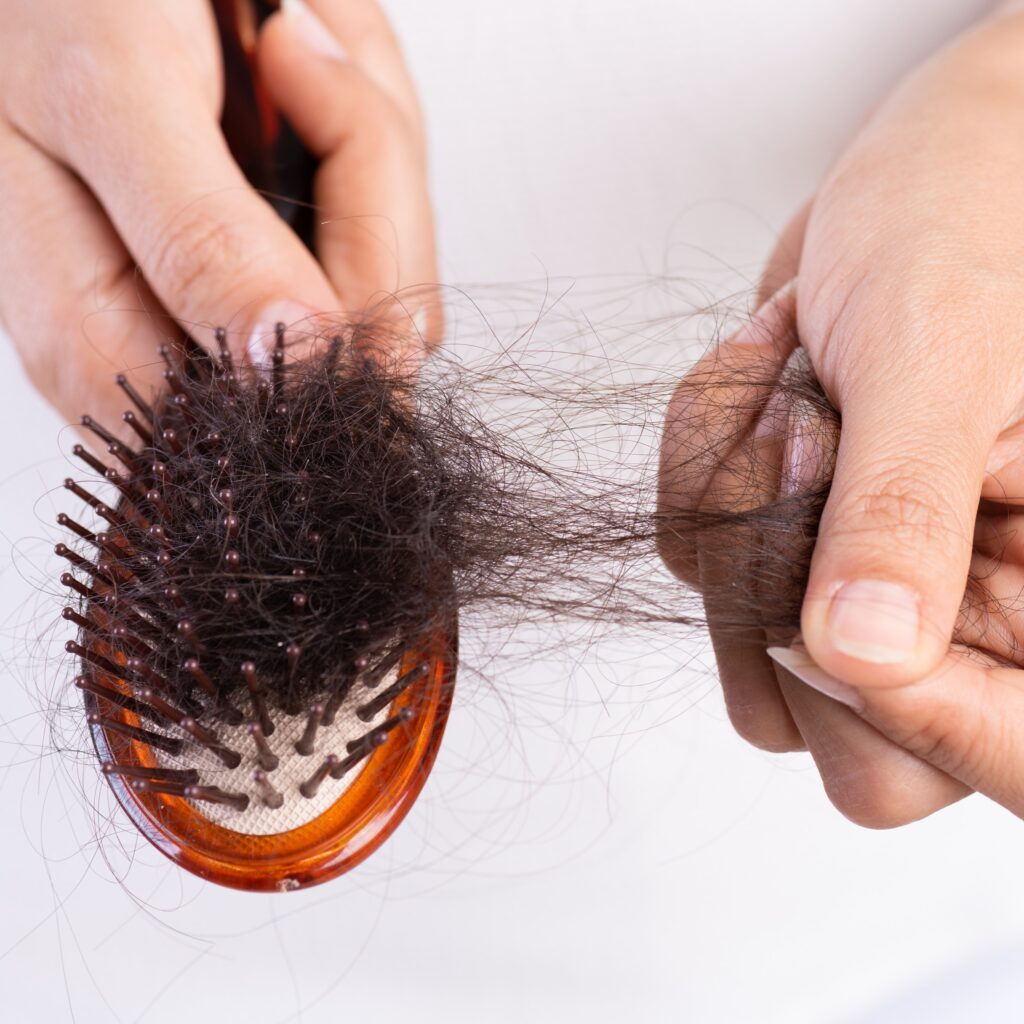Hair loss is a common problem that can have a significant impact on self-esteem and quality of life. In this article we look at the causes, symptoms and treatment options for hair loss in women.
What is hair loss?
Hair loss, also known as alopecia, refers to the partial or complete loss of hair from the scalp or other parts of the body where hair normally grows. Hair loss can occur due to a variety of factors, including genetics, hormonal changes, medical conditions, medications, stress, and age.

The most common type of hair loss is male or female pattern baldness, which is characterized by a receding hairline and thinning hair on the crown of the head in men, and thinning hair on the top of the scalp in women. Hair loss can also occur due to other conditions such as autoimmune diseases, fungal infections, and certain types of cancer treatments.
Could it be Female Pattern Hair Loss?
36% of women after the age of thirty experience some form of hair thinning or hair loss. Female pattern hair loss is a common condition caused by a combination of genetics, hormone levels, and aging.
Hair loss in women is a common concern that can have a significant impact on a woman’s self-esteem and quality of life. While hair loss is often associated with men, women are also susceptible to hair loss and thinning hair. In this article, we will discuss the causes, symptoms, and treatment options for hair loss in women.
Causes of hair loss in women:
There are various reasons for hair loss in women, including:
- Hormonal Changes: Hormonal imbalances can cause hair loss in women. The most common hormonal change that causes hair loss is menopause.
- Genetics: Women can also experience hair loss due to their genetic makeup. This type of hair loss is called androgenetic alopecia or female pattern baldness. It typically results in thinning of the hair on the crown of the head.
- Medical Conditions: Certain medical conditions such as thyroid disorders, polycystic ovary syndrome (PCOS), and alopecia areata can cause hair loss in women.
- Medications: Certain medications such as blood thinners, antidepressants, and chemotherapy drugs can cause hair loss as a side effect.
- Poor nutrition: A diet lacking in certain nutrients such as iron, protein, and vitamins like vitamin D can contribute to hair loss.
- Stress: High levels of stress can also contribute to hair loss in women.
Even hairstyles (that are tight) like ponytails or braids can lead to hair loss because of putting pressure on your hair roots. It is important to consult a healthcare professional to determine the underlying cause of hair loss and to explore treatment options.
Symptoms of hair loss in women:
Unlike male pattern baldness which often leads to a receding hairline and balding at the temples, female pattern baldness usually affects the crown and the top of the scalp. The symptoms of hair loss in women may include:
- Thinning of hair on the top or crown of the head
- Widening of the parting in the hair
- Receding hairline
- Bald patches
- Excessive shedding of hair while brushing or washing the hair
- Sudden loss of hair in large clumps
- Hair clogging drain
Female pattern baldness can progress over time and result in more noticeable hair loss. It is important to note that not all women with female pattern baldness will experience the same degree of hair loss, and the pattern of hair loss can vary from person to person.
Treatment options for hair loss in women
The treatment options for hair loss in women depend on the underlying cause. Here are some of the most effective treatments:
- Medications: Minoxidil (Regaine) is an over-the-counter medication that can help to regrow hair. Finasteride (Propecia) is a prescription medication that can also be effective in treating hair loss in women.
- Hair Transplantation: Hair transplantation involves transplanting healthy hair follicles from one part of the scalp to another. This is a surgical procedure that is typically recommended for women with advanced hair loss.
- Hairpieces and Wigs: Hairpieces and wigs can be a good option for women who are not interested in medication or surgery. These can be customized to match the colour and texture of the natural hair.
- Lifestyle Changes: Making lifestyle changes such as reducing stress levels, improving nutrition, and getting regular exercise can help to improve hair health.
- Supplements: Healthcare professionals may recommend some supplements for hair health such as iron, biotin, folic acid, and omega-3 fatty acids (fish oil).
- Low-Level Laser Therapy: Low-level laser therapy (LLLT) uses red light to stimulate hair growth. It is important to note healthcare professionals have varying opinions on whether LLLT is effective or not.
The key takeaway
In conclusion, hair loss in women is a common problem that can have a significant impact on someone’s self-esteem and quality of life. There are various causes of hair loss in women, including hormonal changes, genetics, medical conditions, medications, and stress. The treatment options for hair loss depend on the underlying cause and may include medications, hair transplantation, low-level laser therapy, hairpieces, wigs, and lifestyle changes. It’s important to speak with your healthcare provider to determine the best course of action for your specific needs.




